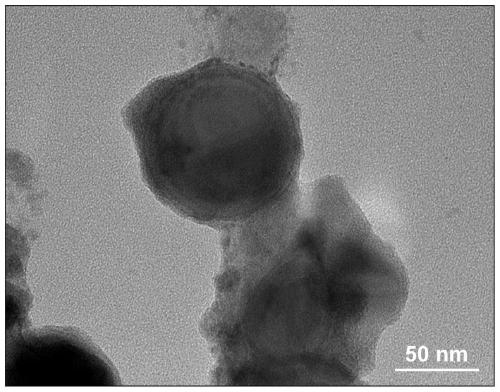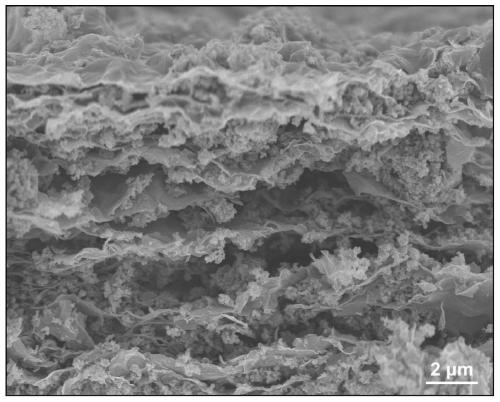Silicon@carbon/MXene ternary composite material for lithium ion battery and preparation method of silicon@carbon/MXene ternary composite material
A technology for lithium-ion batteries and composite materials, applied in the field of silicon@carbon/MXene ternary composite materials for lithium-ion batteries and its preparation, can solve the problems of serious agglomeration of MXene, difficulty in forming a uniformly dispersed composite structure, poor preparation effect, etc. , to achieve high current rate performance improvement, stable cycle performance, and increase the effect of contact reaction area
- Summary
- Abstract
- Description
- Claims
- Application Information
AI Technical Summary
Problems solved by technology
Method used
Image
Examples
Embodiment 1
[0031] (1) Weigh 0.2423g C 4 h 11 NO 3 Dissolve in 200ml deionized water to make 0.01mol / L Tris buffer. Weigh 100 mg of nano-silicon material with a size of about 90 nm and ultrasonically disperse it in Tris buffer, add 100 mg of dopamine hydrochloride, stir for 24 hours, and collect it by centrifugation to obtain Si@polydopamine material, that is, polydopamine-coated silicon material, such as figure 1 shown;
[0032] (2) Re-disperse the Si@polydopamine material in 100ml deionized water, add 25ml MXene dispersion (2mg / ml), stir for 1h and then vacuum filter to obtain the Si@polydopamine / MXene material (mass ratio, Si:MXene =2:1);
[0033] (3) Transfer Si@polydopamine / MXene to a vacuum oven, and vacuum treatment at 60°C for 6 hours, so that the secondary amine groups of polydopamine and the hydroxyl groups on the surface of MXene undergo a crosslinking reaction to form covalent bonds or hydrogen bonds;
[0034] (4) The cross-linked Si@polydopamine / MXene was placed in a tub...
Embodiment 2
[0041] (1) Weigh 0.2423g C 4 h 11 NO 3 Dissolve in 200ml deionized water to make 0.01mol / L Tris buffer. Weigh 100 mg of nano-silicon material with a size of about 90 nm and ultrasonically disperse it in Tris buffer, add 100 mg of dopamine hydrochloride, stir for 24 hours, and collect by centrifugation to obtain Si@polydopamine material;
[0042] (2) Redisperse the Si@polydopamine material in 100ml deionized water, add 100ml MXene dispersion (2mg / ml), stir for 1h and then vacuum filter to obtain the Si@polydopamine / MXene material (mass ratio, Si:MXene =0.5:1);
[0043] (3) Transfer Si@polydopamine / MXene to a vacuum oven, and vacuum treatment at 60°C for 6 hours, so that the secondary amine groups of polydopamine and the hydroxyl groups on the surface of MXene undergo a crosslinking reaction to form covalent bonds or hydrogen bonds;
[0044] (4) The cross-linked Si@polydopamine / MXene was placed in a tube furnace and treated at 600 °C for 2 h under an argon atmosphere to obta...
Embodiment 3
[0048] (1) Weigh 0.2423g C 4 h 11 NO 3 Dissolve in 200ml deionized water to make 0.01mol / L Tris buffer. Weigh 100 mg of nano-silicon material with a size of about 90 nm and ultrasonically disperse it in Tris buffer, add 100 mg of dopamine hydrochloride, stir for 24 hours, and collect by centrifugation to obtain Si@polydopamine material;
[0049] (2) Redisperse the Si@polydopamine material in 100ml of deionized water, add 12.5ml of MXene dispersion (2mg / ml), stir for 1h and then vacuum filter to obtain the Si@polydopamine / MXene material (mass ratio, Si: MXene=4:1);
[0050] (3) Transfer Si@polydopamine / MXene to a vacuum oven, and vacuum treatment at 60°C for 6 hours, so that the secondary amine groups of polydopamine and the hydroxyl groups on the surface of MXene undergo a crosslinking reaction to form covalent bonds or hydrogen bonds;
[0051] (4) The cross-linked Si@polydopamine / MXene was placed in a tube furnace and treated at 600 °C for 2 h under an argon atmosphere to...
PUM
| Property | Measurement | Unit |
|---|---|---|
| size | aaaaa | aaaaa |
| thickness | aaaaa | aaaaa |
| specific surface area | aaaaa | aaaaa |
Abstract
Description
Claims
Application Information
 Login to View More
Login to View More - R&D
- Intellectual Property
- Life Sciences
- Materials
- Tech Scout
- Unparalleled Data Quality
- Higher Quality Content
- 60% Fewer Hallucinations
Browse by: Latest US Patents, China's latest patents, Technical Efficacy Thesaurus, Application Domain, Technology Topic, Popular Technical Reports.
© 2025 PatSnap. All rights reserved.Legal|Privacy policy|Modern Slavery Act Transparency Statement|Sitemap|About US| Contact US: help@patsnap.com



